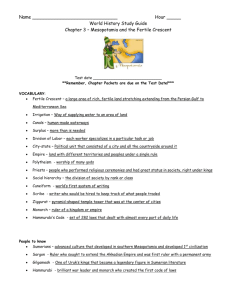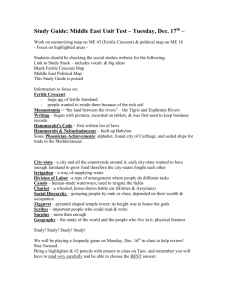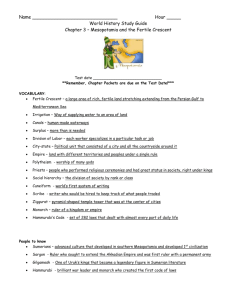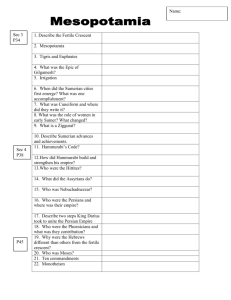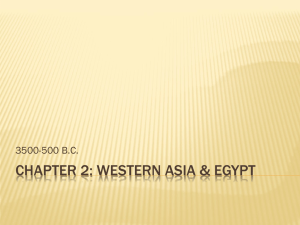Ancient Mesopotamia
advertisement
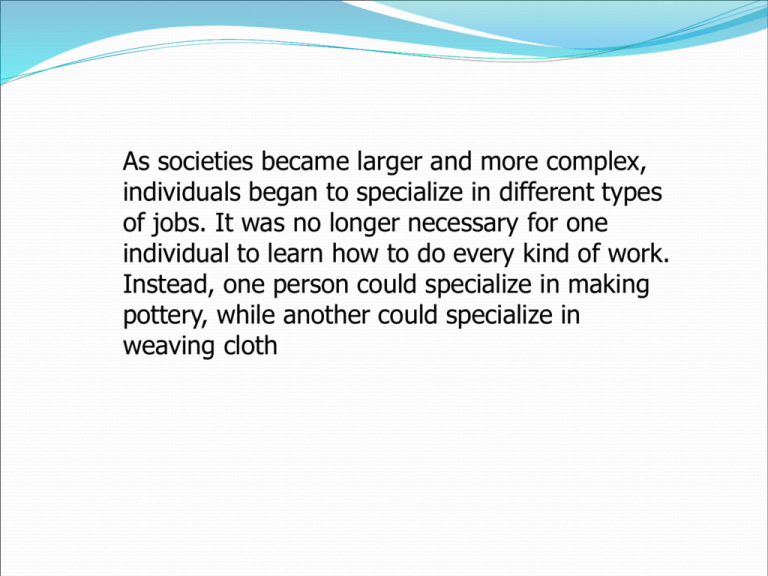
As societies became larger and more complex, individuals began to specialize in different types of jobs. It was no longer necessary for one individual to learn how to do every kind of work. Instead, one person could specialize in making pottery, while another could specialize in weaving cloth Trade Routes Developed As civilizations grew, becoming more advanced, the demand for certain products, such as copper and tin increased. People began to desire products that were not available in their own lands, such as exotic spices, grains, animals, and so forth. At first, trade was simple. Individuals traded goods amongst one another within their own community, or with individuals from neighboring communities. However, within a few short centuries, complex long distance trading routes developed. Specialized traders known as merchants organized caravans that covered distances of thousands of miles, bringing the goods and products of one society to trade them for goods and products from another society. Ancient Trade Routes Develop As the ancient world began to settle into organized communities, people began to trade. At first, trading was made with nearby villages. One big thing led to the growth and development of trade with people groups from farther away: The domestication (training and control) of animals such as camels, donkeys and other beasts of burden made it possible to travel longer distances. Long-range trading was saved for expensive and unusual items. No one was willing to go to the time and expense of transporting goods that could be found locally. Because routes were created for trade with specific places to gain specific goods, the trade routes often had the name of the item they supplied. The Silk Route ran from China to Western Asia and the Mediterranean area. The Spice Route brought rare and wonderful spices form South Asia. Many of these routes became roads and allowed the spread of ideas, religions and culture. Armies also used these routes to conquer what started as trade partners. Written Language Developed As cultures became more complex and evolved, they needed to keep records about their societies. Priests began to record who had donated religious offerings, traders recorded their transactions among different groups of peoples, and leaders recorded their victories in battle, as well as laws for their people to follow. Written language began as pictures known as glyphs. These glyphs represented objects and ideas. Over many thousands of years these glyphs have evolved becoming the letters that we use today. The Fertile Crescent Around 7,000 years ago changing weather patterns forced people to migrate from the Arabian Peninsula Northward in search of water. Decreasing rainfall meant that important lakes and streams, critical to life, were no longer available. 1. What two rivers run through the Fertile Crescent? Tigris & Euphrates Rivers 2. Which two river valley civilizations are shown on this map? Egypt & Mesopotamia 3. In what present day country is Mesopotamia located? Iraq *NOTES* ANCIENT MESOPOTAMIA (4000 B.C.) “land in between the rivers” Why was this a perfect place for the 1st civilization? 1. Fertile Crescent - large arc of fertile land in the Middle East 2. Tigris & Euphrates Rivers made it possible for farming 3. Cattle, pigs, goats & sheep were accessible Fertile Crescent Mediterranean to Persian Gulf Mesopotamia - Means: “Land between the rivers” Tigris and Euphrates flow through region sometimes these rivers flood and leave behind silt after water goes down Silt: rich soil Discussion Question 1 Why did early civilizations likely emerge along rivers ? Sumerians Civilization – 3000 B.C. What is a city-state? A city and surrounding lands with it’s own ruler Much like a modern day country Examples: Eridu, Uruk, Umma, Ur “S” Social Class possible answer Priests Controlled government Acted as go- between with gods Managed irrigation system – demanded crops as taxes “R” “T” or Religion or technology possible answer Ziggurat Religious center City Hall “Mountain of God” Center of all cities Conduct rituals at the top of the ziggurat Ziggurat at Ur Monarchs Time of war a strong man took over Gave back power after war Monarchs to Dynasty Military leaders became full rulers Rulers passed on power to sons – This establishes a dynasty “P” political potential answer Discussion Question #2 How did ancient Sumer move from a theocracy to a monarchy? Polytheism and Sumerian Gods Belief in many Gods “R” Religion possible answer - almost 3000 god & goddesses - controlled forces of nature Had human qualities Immortal and all powerful Most powerful god was Enlil clouds and air Sumerian and their Gods Lowest of all Gods were Udugs – Cause disease and misfortune Humans were god’s servants – Offered sacrifices to keep Gods happy Innovations Wheel, Plow, Sail Cuneiform: earliest form of writing - 2300 B.C. - Gilgamesh: world’s oldest epic poem • astronomy, chemistry, medicine Architectural innovations - arches, columns, ziggurat “T” technology possible answer Activity: Epic of Gilgamesh Reading Question to Consider: Who came first: Gilgamesh or Noah? How do you know? Was there actually a “great flood”? Why? Warm Up Read the excerpt from Hammurabi’s Code. Answer the Questions and remain QUIET!!!! Cuneiform Tablet Mesopotamian Empires Around 2,000 B.C., the Sumerian city-states were conquered and united by a succession of rulers and empire builders. The first of these was a man by the name of Sargon. First Mesopotamian Empires Sargon conquered most of the Fertile Crescent - He was an Akkadian Adopted Sumerian culture Established first empire Brings together people under 1 ruler Hammurabi and the Babylonian Empire After the decline of Sargon’s Akkadian Empire, the Sumerian city-states fell into decline. Eventually a new leader by the name of Hammurabi rose to power. “E” Economy potential answer Cultural Diffusion Sumerian food surplus leads to long distance trade This leads to the spread of ideas and products from one culture to another Discussion Question #3 Why were so many empires able to emerge in the Mesopotamia region? Explain. Babylonian Empire Hammurabi’s Code Hammurabi established a series of written laws describing the various violations and what the appropriate punishments would be. These laws were written down, establishing the first written system of justice. This is considered to be one of Babylon’s greatest achievements. - 1792-1750 B.C. - collection of 282 laws - Applied to everyone, but not fair to everyone. - Based on the idea of an Eye for an eye, -- It was fair to the victims, but unfair to the accused and served in favor of those of higher social standing. - Patriarchal: dominated by men, women had few rights Code of Hammurabi reading Discussion Question #4 and #5 What was the purpose of Hammurabi’s Code? Was Hammurabi’s fair to all people?
